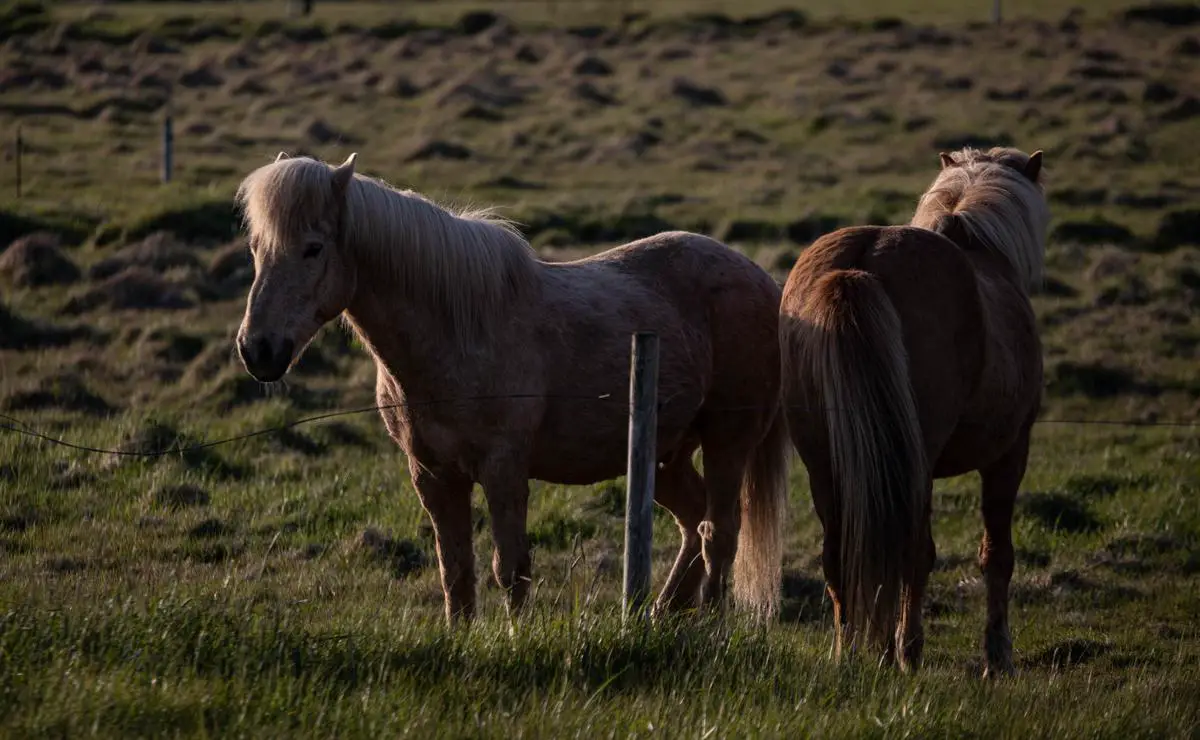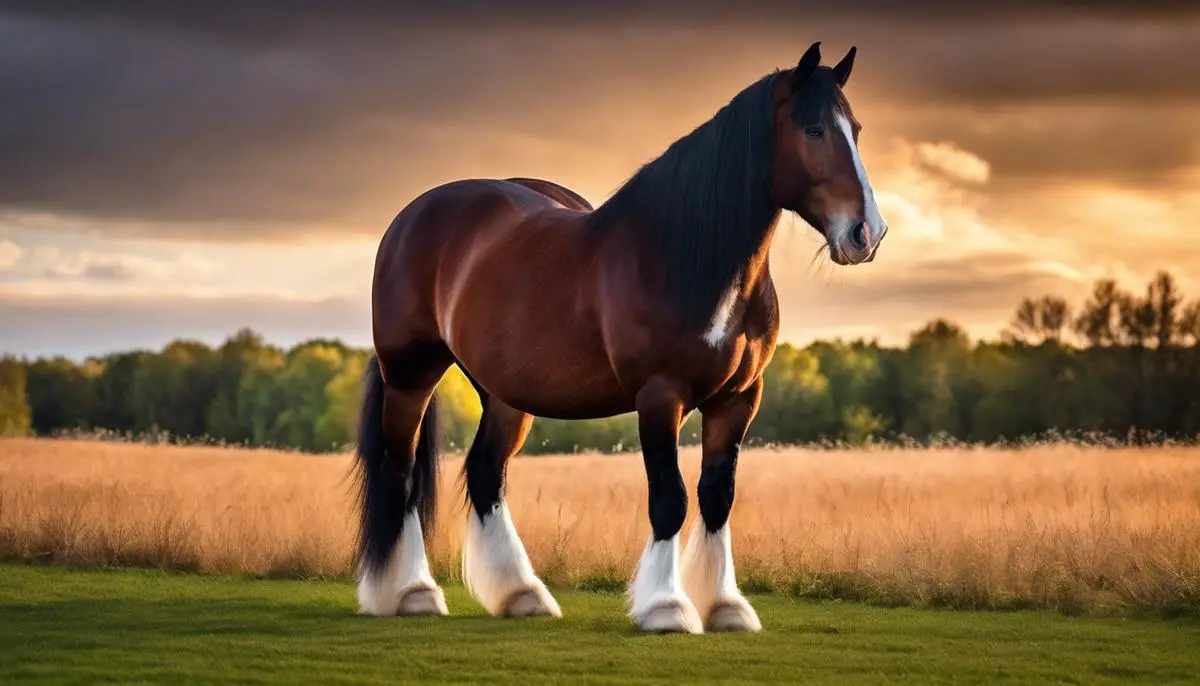For centuries, the Clydesdale horse breed has been intertwined with human history, appreciated not only for its strength and durability, but also for its gentle demeanor and striking appearance. Originating in Scotland, these impressive equines have captured the hearts of those far beyond their native land, emerging as one of the most recognized and admired breeds in the world. This exploration delves into the fascinating history of the Clydesdale, its captivating physical characteristics, its unique care and training essentials, and its profound influence on popular culture. A closer look at these “gentle giants” unravels a rich tapestry of undeniable charm, ardent perseverance, and memorable contributions to human society.
Table of Contents (Horspedia)
History and Origin of the Clydesdale Breed
As the timeless saying goes, “You have to know where you come from to know where you’re going.” And, this couldn’t be truer for patrons of the equestrian world, particularly those intrigued with the Clydesdale breed. It’s not merely about appreciating their strength or dazzled by their grace; digging deeper into the history and early developments of this remarkable horse breed reveals more than its formidable presence. It’s a captivating story queued with rich heritage, evolution, and a testament to perseverance.
Humble Beginnings: Clydesdale Birthplace
In the heartlands of Scotland lies the origin of the Clydesdale breed. The name ‘Clydesdale’ is derived from ‘Clydesdale,’ a locale in Lanarkshire, and former county near the River Clyde. Here, in the 18th century, the first Clydesdale came into existence. Optimized for laboring in the valley farms, these early representatives of the Clydesdale breed were more compact and less imposing compared to today’s specimens, yet undeniably robust.
A Foundation from Flemish Horses
At the heart of the Clydesdale breed, we encounter influence from the now-extinct Flemish horses. Interestingly, around the mid-18th century, these large and commanding horses were harnessed for the indispensable role of draft animals. In that quest to cultivate a horse breed conducive for heavy work enduring the rugged Scottish land, local mares were bred with Flemish stallions, kindling the genesis of the Clydesdale breed.
The Evolution
Certainly, it’s not by mere chance the Clydesdale breed excelled. Deliberate efforts to shape suitability for the intensive labor in the mines and farms, plus freight hauling in the cities meant crossbreeding had to come into play. By the early 19th century, breeders targeted larger sizes, leading to the introduction of the Shire horse into the Clydesdale lineage. The resultant Clydesdale horse was stronger, flexing its muscle in heavy hauling and large scale agriculture.
Steadfast Against Peril
The Clydesdale breed, despite its persistent refinement, did not navigate the tumultuous waves of time unscathed. With two World Wars and increasing mechanization, the breed was on the brink of extinction in the mid-20th century. However, passionate breeders wouldn’t watch the Clydesdale adorned legacy sink into oblivion. Concerted efforts on breeding and conservation, particularly in the US, fanned the dying breed back into a promising population boom.
The Clydesdale Today
Fast-forward to today, the Clydesdale stands tall, embodying the agrarian spirit, the struggles, and the triumph in its lengthy history. Colossal yet graceful, awe-inspiring and with a recognizable stocky and hairy-legged silhouette, the Clydesdale breed continues to win hearts all over. Whether it’s for draft work, riding, or simply show-stopping in parades and festivals, the Clydesdale stands proud, a testament to its enduring place in equine history.
In conclusion, understanding the roots and early developments associated with the Clydesdale breed helps to appreciate the journey it undertook to be the breed we know and love today. It’s a rich tapestry woven with evolution, purpose-driven refinement, and a resilient knack to weather the harshest storms. A true heritage breed!

Physical Characteristics and Traits of Clydesdales
The Distinguishing Characteristics of the Clydesdale Horse
One of the most identifiable features of a Clydesdale horse is its impressive size. Typically standing between 16.2 and 18 hands high (a ‘hand’ is about 4 inches, measured at the shoulder), they’re undeniably large creatures. In fact, mature males can weigh between 1800 and 2200 pounds, while females range anywhere from 1600 to 1800 pounds. But it isn’t just their size that sets these horses apart.
Clydesdales are characterized by their stout, muscular build, evident even at a distance. Their strong, broad backs and powerful hindquarters showcase their striking strength, making them ideal workhorses. Drawing a closer look, you’d observe their arched neck adding a touch of elegance to their sturdy silhouette. Add the gentle curve of their well-formed ears, and it’s easy to see why they’re such a beloved breed among horse enthusiasts.
One defining aspect of Clydesdales that cannot be overlooked is the signature ‘feathering’ on their lower legs. These long, silky hairs around their fetlocks give the appearance of a gentle wave as they move, dancing to the rhythm of their powerful strides. Pair this feature with their broad hooves, and there’s no mistaking a Clydesdale.
Predominantly bay in color (think deep, rich brown), Clydesdales have white markings on their face and legs. The variation of these markings adds to the unique individuality of each Clydesdale and contributes to their overall charm. No two Clydesdales are identical, making them a truly distinctive breed.
As for the Clydesdale’s temperament, it’s just as endearing as their physical traits. Despite their imposing stature, they’re known to be calm, friendly, and exceedingly patient. These horses are gentle giants, exhibiting an affable nature that makes them a joy to handle. This combination of strength and gentility makes Clydesdales ideal for a wide range of uses, including farming tasks, riding, and ceremonial purposes.
To truly grasp the majesty of the Clydesdale horse, one needs to see this creature in motion. Their movement is energetic yet graceful with a certain flair that leaves you captivated. Understanding the strength, elegance, and gently spirited nature of these horses truly underscores why they are so esteemed today, cementing their place in equestrian history and ultimately, our hearts.

Clydesdales Care and Training
As lovers of the magnificent Clydesdale breed, proper care and training becomes an absolute priority to keep them in good health and high spirits. Here’s a quick guide to caring for and training these gentle giants.
Given the Clydesdale’s size and strength, it’s crucial to provide them with ample space to graze and exercise, ideally a large grassy pasture. A stall should be spacious, well-ventilated, and routinely cleaned with fresh bedding to ensure their comfort and prevent potential health issues.
Horse nutrition is a science in itself; Clydesdales require a well-balanced diet to maintain their health and energy. Mainly, their diet should consist of hay or grass, preferably supplemented with grains, vitamins, and minerals. An average adult Clydesdale may consume 25-50 lbs of hay and 2-10 lbs of grain every day! Don’t forget clean, fresh water kept available all times.
Grooming is not just about appearance, but mainly about health and bonding. Regular brushing helps remove dirt, prevents skin conditions, and promotes blood circulation. Their unique feathering requires extra attention to prevent infection and matting. It’s also a chance for you to check for potential injuries or early signs of illness on their body.
When it comes to training, slow and steady is the way to go. Clydesdales are intelligent creatures and can sense their handler’s emotions. Therefore, ensuring the handler is calm and patient throughout training sessions will encourage a willing and harmonious relationship.
Use positive reinforcement like treats or affection as rewards, making the learning experience enjoyable for the horse. Beginning with general groundwork – walking, turning, stopping – forms the basis of all subsequent training.
Make sure to provide regular exercise to maintain their physical strength and cardiovascular health. This can range from simple daily walks to more rigorous activities like pulling or riding, depending on the individual horse’s capacity.
Routine health check-ups should be scheduled with a trusted equine veterinarian – this includes vaccinations, worming, dental, and feet care. Remember, a healthy Clydesdale is a happy Clydesdale!
Finally, socialization is an aspect of horse care that’s often overlooked. These are herd animals and cherish companionship. Allow your Clydesdale to interact with other horses or people to help tame their temperament and manage stress.
In essence, a Clydesdale horse requires a blend of proper nutrition, accommodation, grooming, exercise, training, health care, and socialization to thrive. It’s a serious commitment filled with challenges, but the bond you form with the horse is worth every bit of the effort, marking an undeniably rewarding experience. It’s about fostering a deep respect and understanding of these noble creatures, whose remarkable strength, gentle nature, and unique beauty are a true testament to their enduring relevance in our lives.

Clydesdales in Popular Culture
Our beloved Clydesdale’s regal stature and signature feathered hooves have not only been a major part of equestrian history but have also been a remarkable presence in contemporary pop culture. Their grace, strength, and distinct appearance have made them a public favorite and a frequent choice for varied media portrayals.
In the realm of TV and Film, Clydesdales are famous figures. Perhaps the most notable appearance in Western media has been their long-standing association with Anheuser-Busch. Those iconic Budweiser Clydesdales commercials that air during prominent sporting events, particularly the Super Bowl, aren’t just loved by horse enthusiasts, but by millions of viewers globally. This team of majestic horses pulling a red, white, and gold beer wagon is symbolic of Budweiser’s tradition and has remained a TV favorite since their first ad in 1933.
Beyond the commercials, Clydesdales have been stars of the silver screen too. Films such as “Five Pound Note” and “The Clydesdale: America’s Horse” have helped to replicate the personality and hard-working nature of the breed on film, adding to their popularity and public recognition.
In popular literature, Clydesdales have featured in adolescent and children’s books like “Blaze and Thunderbolt” by C.W. Anderson and “Hannah’s Dream” by Diane Hammond. These stories, showcasing their majestic beauty and gentleness, introduce younger generations to the Clydesdale breed, thereby ensuring their continued fame.
Clydesdales also have a strong social media presence. Thousands of photos and videos of Clydesdales can be found on platforms such as Instagram, Youtube, and Facebook, posted by both enthusiasts and professionals. Engaging content like the Budweiser Clydesdales making a “snow day” or the spectacle of Clydesdales showcasing their prowess in numerous competitive events rack up views and shares globally.
In parades and festivals, the presence of Clydesdales is undeniably magnetic. From local county fairs to national holiday parades, their grand size, distinctive look, and docile disposition continue to draw awestruck crowds. Examples include their participation in the annual Tournament of Roses Parade, where they are a highly anticipated spectacle.
Despite their size and strength, Clydesdales have a way of winning hearts softly. Their endearing performance in music videos, even those in contrasting genres like country music’s “Beer for my Horses” or the rock band – The Cult’s “Spiritwalker” video, only serve to illustrate this versatility.
In summary, the Clydesdale’s charm and strength extend beyond the paddock. Their striking appearance, steeped in history and tradition, coupled with their gentle and friendly disposition, has cemented their place in pop culture. Whether on screen, in print, or at live events, Clydesdales continue to captivate audiences, helping to ensure the breed’s survival and growth. The wave of love and appreciation for these horses is undeniable and truly represents their strong and enduring influence in popular culture and media.

Indeed, the majestic Clydesdale breed stands as a beacon of strength, beauty, and resilience in the equine world. Their unique physical traits, reinforced by their equally unique and compassionate personality, have captivated millions, making them a beloved symbol in many regions worldwide. The commitment to their care and training continues to underscore our longstanding relationship with these incredible creatures as we learn, grow, and evolve with them. By examining their rise to fame in popular culture, we are reminded of their enduring influence and the indelible mark they have left on our collective human story. The Clydesdale doesn’t merely exist – it embodies a rich history, symbolizes our shared success, and continues to inspire with its unforgettable legacy.

